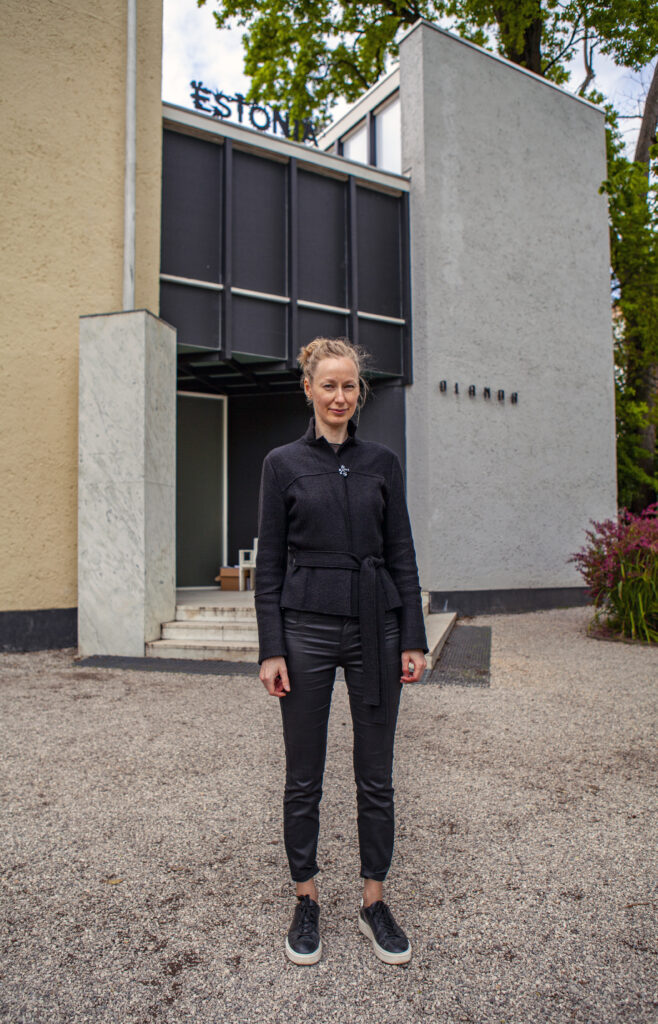
Kristina Norman (1979) is an artist whose interdisciplinary work includes video installations, sculptural objects, and interventions in the city space, as well as documentaries and performance. Norman’s artistic practice is context-focused and she works with themes that relate to ideologies, controversial political processes and the sore points of history, looking for ways to approach polarising subject matter beyond mutually exclusive narratives.
A notable part of Norman’s work addresses the collective memory and identity through monuments. One of her most well-known projects “After-war” represented Estonia at the 53rd Venice Biennale in 2009 (curated by Marco Laimre). The work was based on the story of the Bronze Soldier, a monument to the Soviet army that the Estonian government had removed from Tallinn city centre in 2007, which was then replaced by a golden replica of the statue by Norman. Through this intervention the artist was looking for ways to use the golden monument to draw attention to the various groups living in Estonia who do not share the same historic memory. “After-war” was based on Norman’s several previous projects addressing the Bronze Soldier, such as the film “Monolith” (2007), and the installation “Community” (2007) that consists of souvenir size figurines of the Bronze Soldier, painted in the colours of various pop culture characters.
This was followed by the film “A monument to please everyone” (2011) looking at the process of putting up the monument to commemorate the Estonian War of Independence. The film focused on the reorganising of the landscape of Estonian collective memory and correlating it to the nation-focused narrative immediately after the Bronze Soldier was moved. This was also a project for the people in power to establish their political will that came to divide the mostly Estonian-speaking public regarding the monument’s name and meaning (a monument to freedom or a statue to victory) as well as its aesthetic qualities. Following the young patriotic authors of the monument and the politicians who directed them, the film shows the behind-the-scenes of the process.
Her following works “0.8 square metres” (2012) and “Common Ground” (2013) also address perpetuating or erasing collective memory, tied together into a trilogy by an artistic exploration of spatial aspects of remembering and relying on historic parallels. In 2014 Norman took part in the 10th Manifesta Biennial in St. Petersburg (curated by Kasper König and Joanna Warzsa) with the public sculpture project “Souvenir” (2014) and a video installation “Iron arch” (2014). The work presented an 8-metre tall metal structure resembling a Christmas tree, referring to the Euromaidan revolution and its symbol, Yelinka. The sculpture was accompanied by a video, where Alevtina Kakhidze, a Ukranian artist, recalls events in Kiev while standing on the Palace Square in St Petersburg.
The audiovisual work “Festive spaces” (2016) is a lecture-performance that focuses on the creation of ideological spaces and how they are deployed in various contexts. The video looks at the polemics created by the pro-Soviet wall panel by the artist Evald Okas, located at the Estonian History Museum: as Russian language schools often use it as a backdrop to their class photos. Critically addressing the real-life subject matter, Norman suggests a possible future scenario on how to tame the ideologically non-compliant space.
At the group exhibition “The state is not a work of art” (curated by Katerina Gregos) Norman exhibited the video “Bring back my fire, gods” (2018), where the opera singer Sofia Jernberg sings the composition “Transvaal” by the Estonian composer Märt-Matis Lill at the Estonian Song Festival Grounds; a place closely tied to the historic national awakening, the Singing Revolution and re-gaining of independence in 1991. This work asks the following questions: what is the Estonian nation and the tradition of song festivals? Who and what songs represent a nation?
“Lighter than a woman” (2019) is a poetical-documentary performance, where Norman looks at Ukrainian migrant workers who live in Italy and who have become caregivers for Italian elders, juxtaposing their hard work with the achievements of Samantha Cristoforetti, an Italian female astronaut, who went into outer space. The central motif of the piece is gravity and overcoming it, highlighting women’s freedom of choice, their sacrifices and strength.
At the 59th Venice Biennale (2022) Estonia will be represented by Kristina Norman’s and Bita Razavi’s “Orchidelirium. An appetite for abundance” (curated by Corina L. Apostol). The exposition is inspired by the work of Emilie Rosalie Saal (1871–1954) – her watercolours and paintings depicting tropical plants which the artist made during her travels to the former Dutch East Indies. Kristina Norman and Bita Razavi create new works based on Saal’s legacy, asking locally and internationally relevant questions regarding politics, society, culture, gender, national identity and global processes. The project reflects on entangled histories, the relationship between “winners” and “losers” and the complexity of making sense of it.
Kristina Norman graduated from the Estonian Academy of Arts (BA printmaking 2003, MA fine arts 2010). Her works have been exhibited at the Manifesta Biennial (2014), the Aichi Triennale in Japan (2013), the 53rd Venice Biennale (2009), the 12th Baltic Triennial in Vilnius (2009), the 5th Berlin Biennial (2008). Norman’s works belong to the collections of the Museum of Contemporary Art Kiasma and Art Museum of Estonia. Her performances have been part of several theatre and performance festivals, including Santarcangelo dei Teatri in Italy (2019) and Theaterfestival in Basel, Switzerland (2020). Norman is among the recipients of the national artists’ salary between 2020 and 2022. She is the author of numerous documentaries.